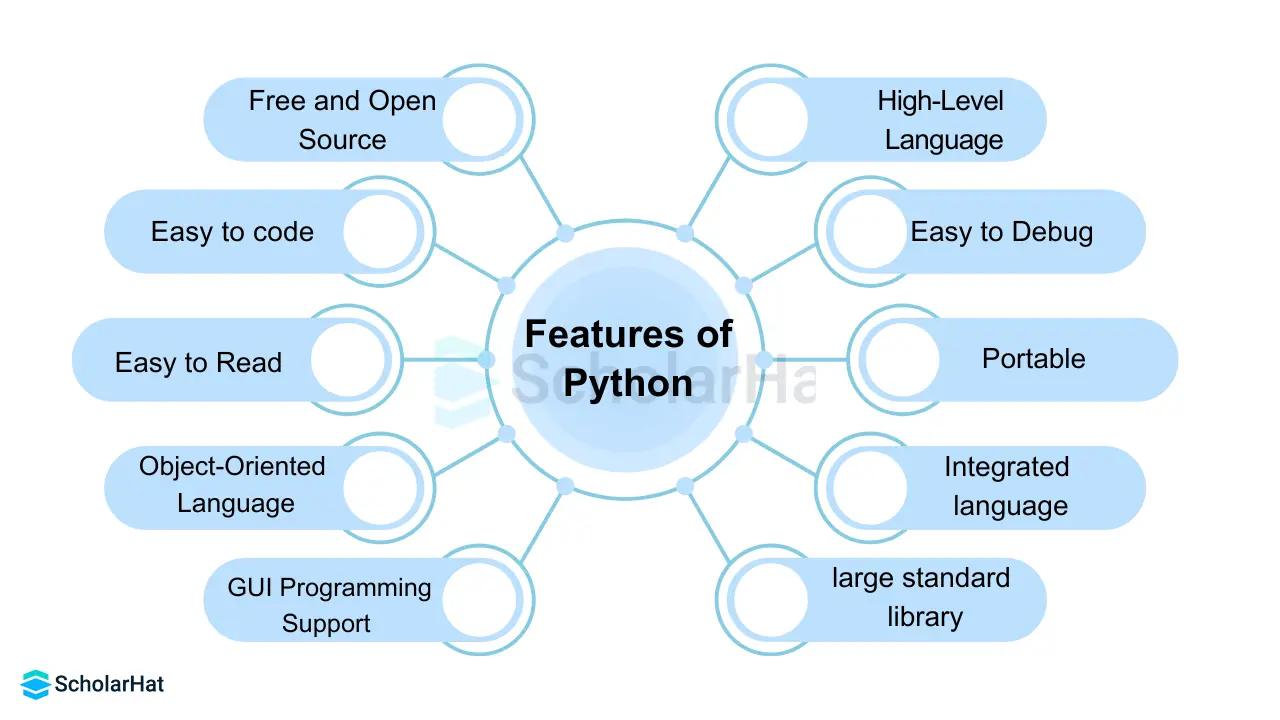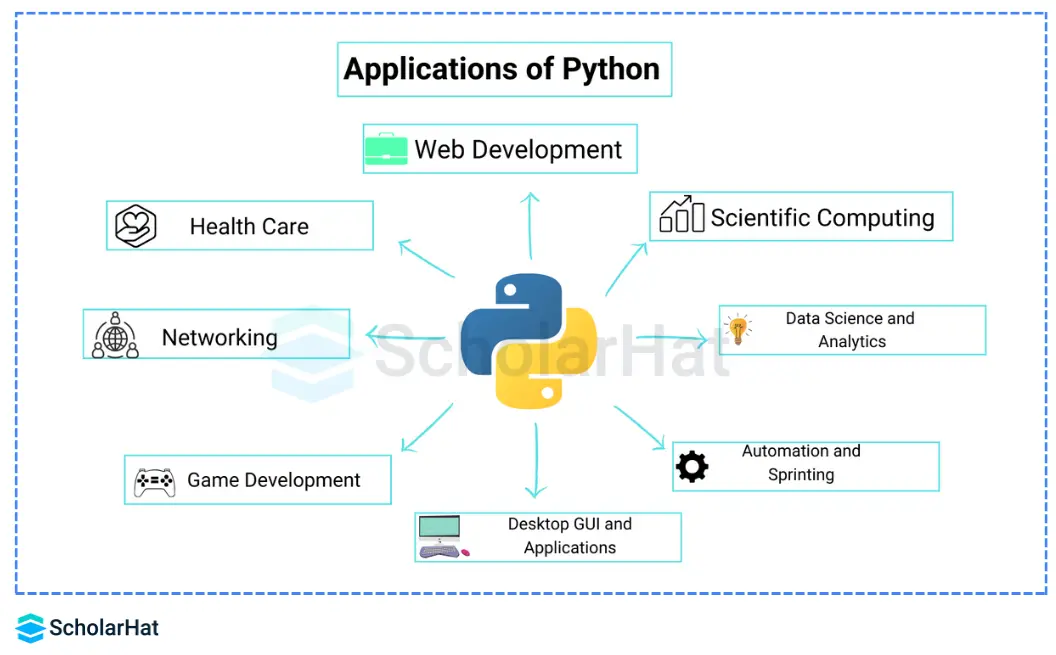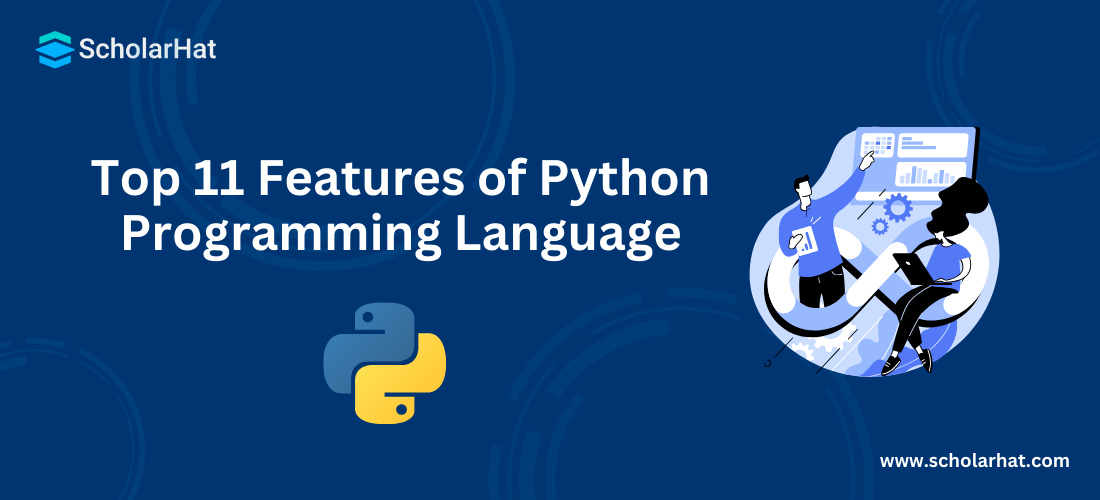18
AprPython Features: A Comprehensive Guide for Beginners
Python features make Python a powerful and versatile coding language that's gaining popularity among developers everywhere. Whether you're just getting started in programming or looking to add Python to your existing skillset, understanding the basics of this code can be beneficial for any tech-savvy individual. In this Python tutorial, we'll explore what is Python? and its Features.Now, let's first look at what Python is and the features of the Python programming language.
What is Python?
Python is a programming language that was created between 1985 and 1990 by Dutch developer Guido van Rossum. Python is an interpreted, object-oriented, high-level language with dynamic semantics. Python is a garbage-collected and dynamic-typed programming language. It offers strong support for integration with other languages and tools, comes with a large standard library, and can be used for scripting, graphical user interfaces, web applications, game development, and much more.
As one of the world's most popular Programming languages, Python is used by organizations such as Google and Facebook; it's also popular among data scientists to make analysis easier. Python provides large frameworks such as Django, Flask, and Pyramid which are very helpful in developing modern digital web applications rapidly. With its user-friendly syntax and cross-platform compatibility, Python has become increasingly essential in the software development industry. The source code of the Python programming language is available under GNU's general public license.
Top 11 Key Features of Python Programming:
In this section, we will see what are the key features of the Python programming language:
1. Free Open Source platform:
Python is developed under an OSI-approved open-source license. It is completely free to use, even for commercial purposes. It costs nothing to download Python, which can be freely modified and re-distributed. You candownload Pythonfrom the official Python website.
2. Easy coding:
It is a very high-level programming language and takes less effort to learn. Anyone can learn to code in Python in just a few hours or a few days. If you want to master the Python language, then all its advanced concepts, packages, and modules might take some more time to learn. However, learning basic Python syntax is not very hard compared to other popular languages such as C, C#, JavaScript, Java, etc. Also, it is very easy to code in Python. Anyone can learn Python basics in a few hours or days. It is a developer-friendly language.
3. Easy to Read & Supports OOP concepts
Learning Python is quite simple. As it was already established, Python’s syntax is straightforward. The code block of Python is defined by the indentations rather than by semicolons or brackets.Python supports object-oriented language and concepts such as classes, object encapsulation, etc.
4. Support for GUI
Graphical User interfaces (GUI) can be made using a module such as PyQt5, PyQt4, wxPython, or Tk in Python. PyQt5 is the most popular option for creating graphical applications with Python.
5. High-Level and Easy to debug
It is a high-level language. When we write programs in Python, we do not need to remember its system architecture, nor do we need to manage the memory.
6. Easy to Debug
Excellent information for mistake tracing. You will be able to quickly identify and correct the majority of your program’s issues once you understand how to interpret Python’s error traces. Simply by glancing at the code, you can determine what it is designed to perform.
7. Portable and Integrated
Python language is a portable language. In short, if we have Python code for Windows and if we want to run this code on other platforms such as Linux, Unix, and Mac then we do not need to change it, we can run this code on any platform. It is also an Integrated language because we can easily integrate Python with other languages such as C, C++, etc.
8. Interpreted Language with a large standard library:
It is an Interpreted Language because Python code is executed line by line at a time. such as other languages C, C++, Java, etc. The source code of it is converted into an immediate form called bytecode. It has a large standard library that provides a rich set of modules and functions so we do not have to write our own code for everything. There are many libraries present in Python for example, regular expressions, unit-testing, web browsers, etc.
9. Dynamically Typed Memory:
In Python, the variable data type does not need to be specified. The memory is automatically allocated to a variable at runtime when it is given a value. Developers do not need to write int y = 20. if the integer value 15 is set to y. You may just type y=20.
10. Supports Community :
Python has increased in popularity over the years because of is one of the biggest communities on StackOverflow. If you need any help with Python queries, the expert community is always there to answer them. A lot of different questions about Python have already been answered on these sites and Python programmers can analyze them as per requirement.
11. Extensible :
Python is extensible. In short, you can extend your Python code in various other languages like C++, etc. too.

| >>>> 10 Python Developer Skills you must know in 2025 |
Applications of Python
There are various Python applications in the field of programming, which are
- Python programming language supports structural and functional programming methods as well as object-oriented programming methods.
- Applications of Python programming help to build large applications. Python can be used as a scripting language or can be compiled into byte code.
- Python supports dynamic type checking and it provides very high-level dynamic data types.
- This particular programming language supports automatic garbage collection.
- Python programming language can be easily integrated with C, C++, Java, COM, CORBA, and ActiveX.

Summary:
Python is an unambiguous, easy-to-read, general-purpose high-level programming language that considers paradigms of structured, procedural, and object-oriented programming. You can use Python and its features for web development, scientific computing, artificial intelligence, software testing, and much more. Additionally, if you're looking to enhance your skills and gain a recognized credential, you may want to consider enrolling in a Python certification course.
Let the quiz begin! Pick the right answers and climb to the top!
Q 1: What type of language is Python?
FAQs
2. Supports Multiple Programming Paradigms.
3. Extensive Standard Library.
- Easy to Read and Learn. Python is a simple language to read and learn.
- Reduces Maintenance Costs.
- Avoid the Harm of Software Bugs.
- Wide Applicability.
- Easy Memory Management.
- Large Community.
- Asynchronous Coding.
- Integration with Other Languages.







